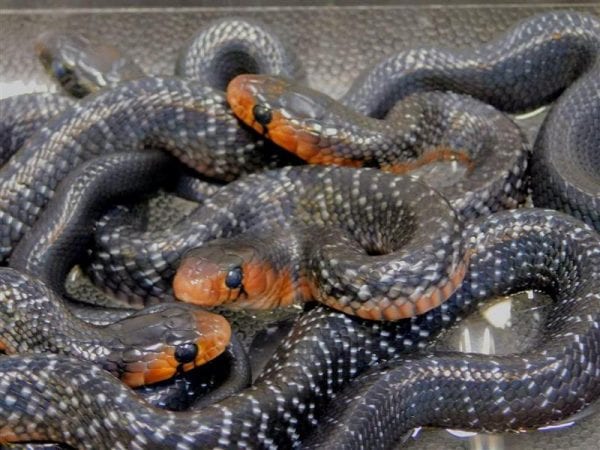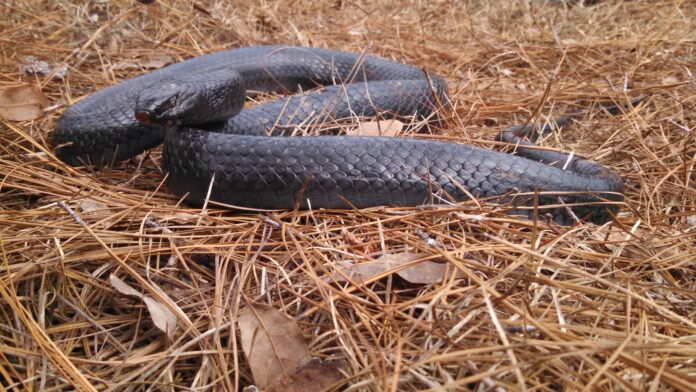AUBURN UNIVERSITY, Ala. – The Eastern indigo snake, one of the longest snakes native to the United States, calls the Southeast home. Unfortunately, this staple reptile’s survival is at risk, especially in Alabama. In fact, these snakes are a federally threatened species under the Endangered Species Act. In order to decrease the chances of their extinction, reintroduction programs are crucial.
Historically, Eastern indigo snakes were found in the coastal plain regions of southern Georgia, Alabama, southeast Mississippi and Florida. Currently, they are found in parts of southern Georgia and Florida. Typically, these snakes live in longleaf pine ecosystems within the coastal plain and adjacent drainages.
“The decline of the species throughout its range is one of the big drivers for reintroduction,” said Bence Carter, an Alabama Extension forestry, wildlife and natural resources regional agent.
Also, people consider these nonvenomous snakes an apex predator and are an important part of the ecosystem, making it even more essential to reintroduce the species to its environment.
Reintroduction efforts
The first attempt to reintroduce these snakes in Alabama occurred in the 1980s on multiple sites in the southern region of the state. Auburn University’s Dan Speake spearheaded these initial attempts. Surveys conducted from 2004 to 2006 showed that these first attempts did not establish any viable populations.
In 2008, interest arose to attempt to reintroduce Eastern indigo snakes in hopes to create a viable population in the Conecuh National Forest. Jimmy Stiles, a doctoral student within the Auburn University School of Forestry and Wildlife Sciences, has been a part of the reintroduction project.
“To have snakes to release, females with eggs were captured from Georgia and taken to Auburn where they laid their eggs,” Stiles said.
The females were then released back where they were captured from. Out of each clutch of hatchlings, professionals kept both male and female snakes to create a captive breeding program.
“This captive breeding program now produces all of the snakes currently released,” Stiles said.
In 2010, after two years of growth, the snakes were released again in the Conecuh National Forest and have been continuously released over the last decade. So far, the project released approximately 190 Eastern indigo snakes into the Conecuh National Forest. After their release, professionals monitored the snakes and conducted several studies about the snake’s ecology.
“This project has shown several signs of success including a high survival rate and habitat use that mirrors wild indigo snakes,” Stiles said.
Recently, wild reproduction has been documented, indicating that the population is increasing on its own.
Proper habitat
In addition to the reintroductions to unfragmented sites, like the Conecuh National Forest, there is a push to increase available habitats through management practices like longleaf pine restoration and prescribed fire. In Alabama, Eastern indigo snakes rely on open pine savannas managed with frequent, low-intensity fire. Habitat fragmentation played a part in the species decline, so large uninterrupted tracts of land are important as well. The pines are critical because they provide fuel to carry fire. This in turn reduces woody shrubs and promotes native grasses and forbs.
Carter said this management process can help set up a chain of events that eventually helps Eastern indigo snakes.
“This process increases the potential for gopher tortoise populations,” Carter said. “Gopher tortoises make burrows in the ground. These are important to the survival of the species (Eastern indigo snakes) because they provide refuge during the colder months.”
Stiles said early radio telemetry work done on the released snakes shows that over 90 percent of the snakes use gopher tortoise burrows to survive the winter.
Eastern indigo snakes use both upland pine and lowland hardwoods during the year. They will use the pine uplands for breeding and will hunt in wetlands and creek bottoms during the summer. Recent studies have also shown that the indigo snakes’ preferred prey are venomous pit vipers, such as rattlesnakes and copperheads.
More information
With the combined reintroduction efforts and positive reproduction results, the future for the Eastern indigo snake is looking up. However, continuous monitoring and preservation is necessary to ensure the species stabilizes their population. For more information about the Eastern indigo snake, or other snakes in Alabama, visit the Alabama Extension website www.aces.edu.





















